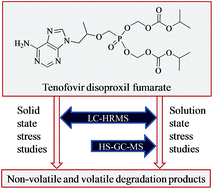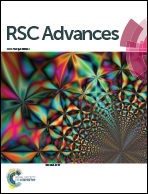Stability behaviour of antiretroviral drugs and their combinations. 1: characterization of tenofovir disoproxil fumarate degradation products by mass spectrometry†
Abstract
Tenofovir disoproxil fumarate (TDF), an antiretroviral drug, was evaluated for its degradation behaviour in solid and solution states. A total of twelve non-volatile degradation products were formed, which were separated on a C18 column in a gradient mode, using methanol and ammonium formate in the mobile phase. The same method was extended to liquid chromatography-high resolution mass spectrometry (LC-HRMS). First a comprehensive mass fragmentation pattern of the drug was established by direct injection and collection of HRMS and multi-stage tandem mass spectrometric (MSn) data. Then LC-HRMS studies were carried on the stability samples containing the degradation products. Also headspace gas chromatography-mass spectrometry (HS-GC-MS) studies were conducted to explore the formation of volatile components. The collated information was utilized for the characterization of all non-volatile and volatile degradation products. Eventually, the degradation pathway of the drug was established under the investigated conditions.


 Please wait while we load your content...
Please wait while we load your content...